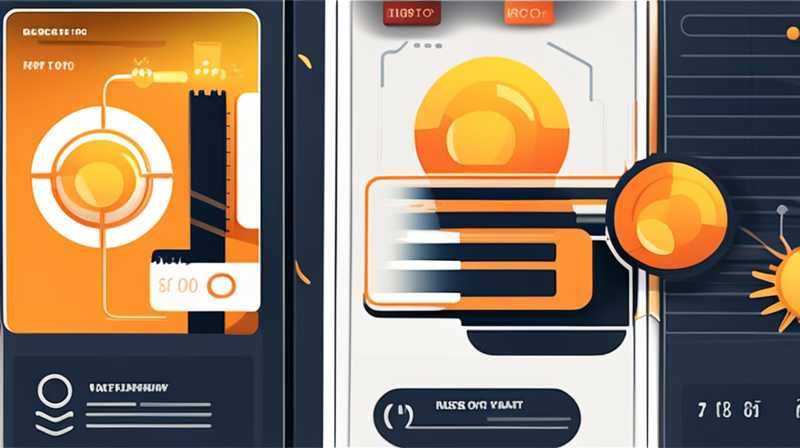
To measure solar current accurately, one should utilize a combination of methods and instruments that capture the nuances of solar power generation. 1.Choose appropriate measuring instruments, 2. Calibrate devices regularly, 3. Consider environmental factors, 4. Analyze data properly. Among these points, it is crucial to select appropriate instruments because the type of meter can significantly influence the accuracy of the measurements. For instance, using a digital multimeter specifically designed for measuring current in photovoltaic systems can yield better results compared to standard alternatives. It is equally vital to understand that environmental conditions such as temperature and shading can affect solar output, so these should be accounted for during measurements to avoid misleading data.
INSTRUMENT SELECTION
Choosing the right instruments for measuring solar current is fundamental in achieving precision. The most commonly used device is the current meter, which can be either analog or digital. Digital meters tend to offer more accurate readings and are easier to read than their analog counterparts. Most solar photovoltaic systems function based on direct current (DC); therefore, a multimeter with DC capabilities is essential.
In addition to choosing a suitable current meter, consider using current clamps. These devices allow for non-intrusive measurements by clamping around a conductor. This setup can facilitate tracking the solar current without disconnecting any cables, hence avoiding potential hazards and minimizing downtime. Furthermore, it is essential to evaluate the meter’s specifications, ensuring it can handle the expected current range. Meters with higher precision and resolution provide a clearer picture of performance metrics.
CALIBRATION OF MEASURING INSTRUMENTS
Calibration of measuring instruments is an often-overlooked step that significantly bolsters measurement reliability. Over time, instruments can drift from their original accuracy due to wear and tear, temperature fluctuations, or exposure to harsh environmental conditions. Regular calibration is vital to ensure that readings reflect true values.
Calibration can be performed through various means, including reference standards or comparing measurements with a known accurate device. It involves measuring the output of your current meter against a standard under controlled conditions. Documenting these results helps in monitoring the performance of your measurement system over time. Establish a calibration schedule, especially if measurements are taken frequently or under varying conditions, to maintain accuracy in your solar current readings.
ENVIRONMENTAL FACTORS
The environment in which solar panels operate plays an essential role in current measurement. Understanding how temperature, shading, and time of year affect solar output can enhance the accuracy of the readings. For instance, temperature influences solar panel efficiency; as temperatures rise, the output current can diminish, which may lead to undervaluation if not accounted for during measurement.
Shading is another notable factor. Even partial shading can drastically reduce the power output of a solar panel. It is vital to consider the orientation of the panels and any potential obstructions when measuring solar current. Regularly monitoring the overall installation’s condition, including any debris that may accumulate on the panels, can positively influence the measurement process. This proactive approach ensures that external factors do not compromise accuracy.
DATA ANALYSIS
Thorough data analysis following the completion of current measurements is critical for making informed decisions concerning solar energy systems. Simple data collection is not sufficient; transforming raw data into actionable insights is essential. Begin by ensuring that data is recorded consistently, including date, time, readings, and conditions.
Next, implement software tools designed for data logging and analysis. These tools can help visualize trends over time, spot irregularities, and understand the relationship between solar input and environmental variables. Analysis can also include establishing baselines for expected performance under specific conditions, allowing for ongoing performance evaluation and system optimization. Maintaining detailed records aids in identifying potential issues, enhancing maintenance schedules, and contributing to overall solar system efficacy.
FREQUENTLY ASKED QUESTIONS
WHAT INSTRUMENTS ARE BEST FOR MEASURING SOLAR CURRENT?
Typically, digital multimeters are preferred for accurately measuring solar current due to their precision and ease of use. For convenience, current clamps can also be employed, allowing for non-intrusive measurements. Both instruments are designed to handle direct current and should be chosen based on their specifications to fit the expected current levels in your solar setup.
HOW OFTEN SHOULD SOLAR METERS BE CALIBRATED?
Calibration of solar meters should be conducted at least once a year, but in environments where temperatures fluctuate frequently or systems experience significant usage, it may be appropriate to calibrate them more regularly. Implementing a systematic calibration schedule will ensure that the measurement tools remain reliable. When making use of reference standards, cross-checking with another calibrated device can also ensure precision in readings.
HOW DO ENVIRONMENTAL CONDITIONS AFFECT SOLAR CURRENT MEASUREMENTS?
Environmental conditions such as temperature, shading, and even weather changes have a substantial impact on solar panel output. For example, extremely high temperatures can decrease efficiency, leading to lower current readings than expected. Shading from nearby objects can also reduce output, which makes it crucial to account for these variables when measuring solar current. By monitoring these factors, one can provide accurate representations of a solar system’s performance.
Careful measurement and analysis of solar current are paramount for optimizing solar energy solutions. Selecting the right instruments is the first step in this endeavor, providing a solid foundation for accuracy. Calibration of these devices cannot be sidestepped, ensuring that optical measurements remain true over time. Environmental variables further complicate assessments but also offer insights into system performance. Through diligent data analysis, one seeks to forge a path toward optimal solar power utility. Each aspect reinforces the others: appropriate instrument choice, regular calibration, consideration of environmental influences, and thorough data analysis contribute to the overarching goal of accurate solar current measurement. These efforts can lead to enhanced performance, longevity, and efficiency in solar energy systems, driving the transition towards cleaner energy sources. As solar technology continues to evolve and integrate into more households and industries, mastering the intricacies of current measurement becomes not merely advantageous but essential for sustainability and energy independence.
Original article by NenPower, If reposted, please credit the source: https://nenpower.com/blog/how-to-measure-solar-current-accurately/


